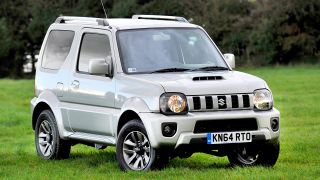![]() The content of any article might be expanded / improved in the future - revisit it sometimes.
The content of any article might be expanded / improved in the future - revisit it sometimes.
![]() Seen a mistake? Know something that isn't written? Edit and change this article yourself!
Seen a mistake? Know something that isn't written? Edit and change this article yourself!
![]() Some images in the article (if present) can be enlarged by clicking on them.
Some images in the article (if present) can be enlarged by clicking on them.
Contents
Introduction
Jimnys have been in production since 1998, and there have been three front bumper models on them:
- 1st gen. bumper (1998-2005)
- 2nd gen. bumper (2006-2012)
- 3rd gen. bumper (2013-ongoing)
All of those are made of plastic.
Main characteristics of each bumper generation:
- The 1st gen bumper is the smallest one (does not hang too low to the ground).
- The 3rd gen. bumper also is not bad.
- However, 2nd gen. bumper is overly large (hangs very low to the ground), and it significantly reduces the approach angle - the risk of it hitting the ground is quite higher than with other two bumper models.
- 2001 Jimny UK).jpg
1st gen. front bumper on a 2001 model year Jimny
Problems with 2nd gen. front bumper
The 2nd. gen front bumper is the most endangered point when off-roading, and it's easy to damage.
Also, 2nd gen. bumper reduces the space around the front wheels, limiting the size to which the wheels can be increased (by using larger tyres). With 2nd gen bumper, the usual limit is 205/75/R15 (and even that size sometimes makes a contact if the bumper is sagged), while with the 1st gen bumper even 215/75/R15 is not a problem.
For all the mentioned reasons, some people cut out (trim) the bottom half of the 2nd gen. front bumper, but it tends to look ugly.
Alternative solution is to replace 2nd gen. bumper with something else.
Solution 1: Factory bumper generation swap
If you have a 2nd gen. front bumper and you find that it obstructs your vehicle's offroading "potency", the best alternative is to buy a second-hand 1st gen. front bumper (1998-2005) from a scrap yard, paint it if needed, and install it instead of 2nd or 3rd gen. front bumper (the mounts should be almost 100% compatible - but I have not tried yet).
Replacing one edition of a front bumper with another on the same vehicle should be legal (both are genuine parts), and it should not affect the operation of the airbag sensor(s). But this is theoretical assumption.
Restrictions with DDiS Jimnys
If has been confirmed that replacing a 2nd gen front bumper with a 1st gen front bumper is not practical on DDiS (diesel) Jimnys with 63kW (intercooled) K9K engine.
The problem is that the engine intercooler sits low right up front, just above the right fog lamp.
If you try to replace the factory-installed 2nd gen bumper with the 1st gen bumper, you will have to discard the right fog lamp (if you have fog lamps).
You will also have to leave open the right fog lamp hole in the 1st gen bumper, in order to feed the intercooler with air (and even that hole might not be sufficient to feed it).
You should also install some grid in the right fog lamp hole, to prevent an object going through the hole and puncturing the intercooler.
Alternatively, you could dislocate the intercooler, but the free space in the engine bay is very scarce, and moving the intercooler is an expensive modification.
Solution 2: Heavy-duty metal "off roader" front bumper
Another alternative to all these factory bumper generation swaps or trimmings is to buy an aftermarket heavy-duty metal "off roader" front bumper.
Advantages of a heavy-duty metal front bumper:
- Prominent looks;
- Takes a beating off road;
- Typically increases approach angle;
- It can also be used as a mount for driving lights, winch, high lift jack, machine gun, a statue from the front of a ship, etc.
- You have a right to declare one gear as "ramming speed";
However, metal front bumpers have the following disadvantages:
- They might not be legal in certain regions;
- They increase the weight of the front of the car, possibly sagging the front suspension and increasing its wear;
- They might restrict airflow to the engine cooling system, and to the intercooler (if fitted);
- If they stick too far out to the front, they might actually reduce the approach angle;
- Most metal front bumpers will adversely affect the operation of the airbag sensor(s);
- Most metal front bumpers will adversely impact the fate of anything that collides with them;
Page last edited on 25/01/2017 by user Bosanek


